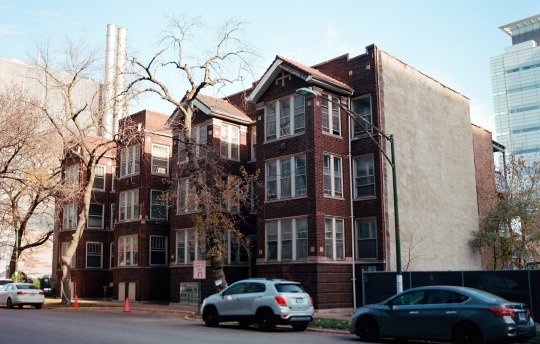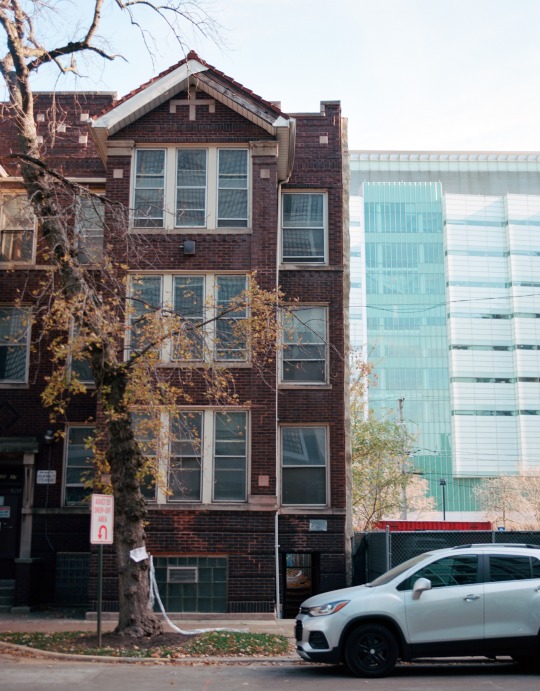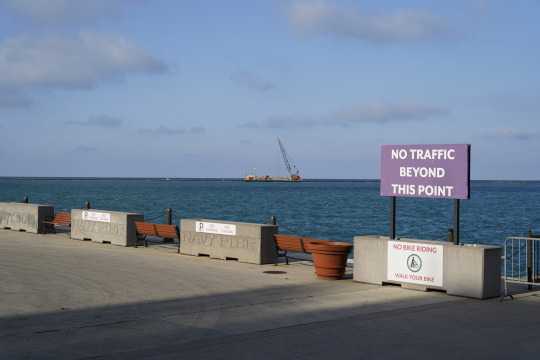Text
Leave the Seat Empty: 5627-5635 South Maryland Avenue

Ed Lin repeatedly told his tenants, onlookers, and all of Hyde Park that he would never sell his properties near 56th & Maryland. He and his wife owned many apartment buildings on the southwestern edge of Hyde Park over the years, dating back at least to the ‘70s, and theirs were the last three to be demolished in an area bordered by 56th, 58th, Cottage Grove, and Drexel.
In several waves beginning in the early ‘90s, the University of Chicago bought out these blocks piece by piece as grounds for their expanded medical center and several campus facilities. The medical center plans were rooted in a strategy to modernize the hospital system, previously primarily housed in a labyrinthine network of neo-gothic buildings that blended academic, research, and treatment uses, and to bring new services in house. The mechanism of expansion was familiar to Hyde Park residents - the monied university spent much of the middle of the 20th century shaping the neighborhood to its will, engaging in a controversial and much-studied campaign of urban renewal.

As recently as the early 2010s, hundreds of people lived on this and the surrounding blocks. But the University of Chicago and their associated medical system moved quickly to construct the West Campus Combined Utility Plant, then the Knapp Center for Biomedical Discovery (seen in the background of the above photo), then the Center for Care and Discovery, then their updated emergency department (partially a result of a community campaign to return level one trauma care to the facility), then the High Bay Research Building, then their recently announced expanded cancer center. By 2021, the only remaining buildings in the university’s zone of interest for these facilities not owned by UChicago were three in the possession of the Lin family, home to dozens of tenants.

Wedged between two of Ed Lin’s buildings, 5627 S Maryland and 5633-5635 S Maryland, was an early 20th century six-flat built much like Lin’s directly to its south. That building was owned by the university itself, and was kept empty for many years following use as office space. The university appeared to put off that particular building’s demolition out of an expectation that they’d be able to demolish it alongside Lin’s buildings one day. That would come true in the fall of 2022.

In 2021, Lin finally decided to sell off most of his remaining rental portfolio - that is, the three buildings in the university’s path. But not without a sweet deal: the trio of structures fetched and astonishing sum of $14 million altogether, many times greater than fair market value for any similar set of buildings elsewhere in Hyde Park. The $2.5 million sale price for the smallest of the three buildings, a tired greystone two-flat at 5627 S Maryland, was the highest sum ever paid for a building of its kind anywhere on the south side of the city.

The demolition of 5627-5635 S Maryland marked the end of an era for Hyde Park, a change that one could moralize in several directions. An entire swath of a city neighborhood was wiped from existence at the hands of an immensely powerful and wealthy private institution. At the same time, UChicago’s path of destruction was also one of construction, widening the range of medical care available on Chicago’s south side and deepening its quality after the slow decline and closure of the marquee Michael Reese research hospital over the preceding decades. The university’s new cancer center will be built on the land upon which these residential buildings once stood.

5627-5635 South Maryland Avenue
Permits issued 11/07/2022
Leave the Seat Empty consists of photos taken of buildings in Chicago in between the time a demolition permit is issued and the time the wrecking crews come.
The vast majority of the city’s demolitions are vernacular residential buildings in areas that are either seeing immense new investment or immense ongoing disinvestment. In most cases, the doomed buildings are not deemed architecturally or culturally notable enough for proactive preservation efforts to succeed, where such efforts exist. They are most frequently replaced by new single family homes, or by empty land. These patterns aren’t universal among demolitions, but are common outcomes of Chicago’s current legal and market environment around land use, building vacancy, and new construction.
Despite its international reputation as a destination for architecture tourism, Chicago’s policies around building demolitions often fail to protect historic structures. There are no easy answers to the question of which buildings should remain standing under which circumstances, but residents lack easy access to information about upcoming demolitions, leaving them unable to campaign effectively against demolitions they might oppose. I seek to document many of Chicago’s doomed buildings in their final days, often with green demo fencing already up, and be present to acknowledge their disappearance.
Photos taken 2022 on 120 format film
22 notes
·
View notes
Text
quick question

why exactly do we need to warn drivers to stop before they drive off the pier?
#chicago
2 notes
·
View notes
Text
actually basketball was invented to prevent tall intrinsically charismatic men from getting involved in politics. without basketball half pints like ron desantis wouldn't be able to win an election for local dogcatcher, much less a statewide office
how would history have changed if mao had been 6’8”
7 notes
·
View notes
Text
the cold war would have played out on the basketball court
how would history have changed if mao had been 6’8”
7 notes
·
View notes
Text
Public Comment On the Federal Management of the Century & Consumers Buildings
The following is the script I used for my public comment to the GSA on the Century & Consumers Buildings on November 10th, 2022. We were each given 3 minutes to present our comments. I learned about this meeting about an hour before it started and wrote my comment in the 30 minutes or so I had before I was called up to speak.
Hello, my name is Aoife, I’m a lifelong Chicagoan, and I’m mad.
I’m mad because the Federal Government is reanimating the corpse of urban renewal to demolish two historically significant buildings in downtown Chicago at the behest of well connected individuals over vague security concerns. This is an embarrassment and demonstrates that we have apparently learned nothing from the past 75 years of failed urban policy. Everyone involved should be ashamed.
If the security concerns are valid, then tearing down the buildings in question will not solve them. The loop is full of skyscrapers, and tearing down these buildings will only open up sightlines to other buildings. Does the Federal Government plan on tearing down the entire loop? If the answer is no, then the security concerns are clearly a farce, and the buildings should remain standing. If the answer is yes, then it is clear that the Loop is not an appropriate place for the Federal complex, and the solution should be relocating to a place that suits such a hysterical mindset. I’m sure there are no shortage of suburbs with similar views on the urban form who would be happy to host the federal government.
I would encourage anyone who claims the Century and Consumers Buildings make their block of State Street moribund† to look in a mirror. It is the federal government and individuals acting on behalf of the federal government which has allowed these architectural masterpieces to waste away as the area around them has boomed. Tearing these buildings down to replace them with a parking lot would not only further this failure, but it would make it permanent.
The good news is that as long as these buildings are standing it is not too late to reverse the past 15 years of mismanagement at the hands of the Federal Government, and preserve these treasures of civic and national heritage. If we tear down these buildings, future generations will look at the vacant lots where they once stood as a testament to our failure
At this point I thanked the audience and yielded about a minute of time back.
When I realized I was going to finish extremely early, I started ad libbing. Mostly to address the fact that these buildings would be part of a potential UNESCO world heritage site. Tearing these buildings wouldn't simply destroy a significant piece of Chicago history, it would be destroying a significant piece of human culture, which affects not just Chicagoans, not just Americans, but the entirety of the human race. It's disgraceful.)
† This was a reference to something the chief judge of the Northern District of Illinois, Rebecca Pallmeyer, said to a landmark panel (as reported in the Chicago Tribune):
"We recognize, again, that this is an issue that draws a lot of attention but we think there really are benefits to a proposal that would eliminate those buildings, particularly for State Street"
Pallmeyer then said the buildings made their block of State "somewhat moribund" and that removing them would allow improved access to the Federal buildings from the east.
#why does my accent get worse when I'm mad#its not every day you get to tell the feds to move to the suburbs#yes i do think judges are cowards
2 notes
·
View notes